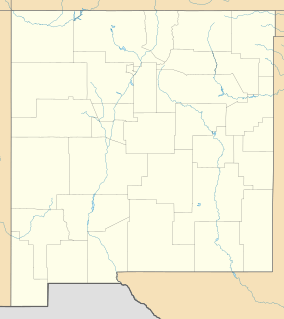Bottomless Lakes State Park facts for kids
Quick facts for kids Bottomless Lakes State Park |
|
|---|---|

View of Lea Lake from the overlook above the lake
|
|
| Location | Chaves County, New Mexico, United States |
| Area | 1,400 acres (5.7 km2) |
| Elevation | 3,500 ft (1,100 m) |
| Established | 1933 |
| Governing body | New Mexico State Parks Division |
Bottomless Lakes State Park is a cool place in New Mexico, a state in the United States. It's located near the Pecos River, about 15 miles (24 km) southeast of Roswell. This park was created in 1933, making it the very first state park in New Mexico!
The park gets its interesting name from nine small, very deep lakes. People used to think they were "bottomless" because they are so deep and dark. These lakes formed in a special way. Long ago, there was an ancient limestone reef, like the mountains near Carlsbad Caverns. Over time, caves formed inside this limestone. As the Pecos River slowly wore away the land, these caves sometimes collapsed. When they collapsed, they left behind deep, round lakes called cenotes.
Contents
The Mysterious Lakes
Most of the nine lakes in the park are surrounded by tall cliffs. But there are a couple of exceptions: Lea Lake and Lazy Lagoon. Lea Lake has a big, sandy beach on one side, which is great for visitors. Lazy Lagoon's cliffs have worn away, and it now sits in an old path of the Pecos River.
Lazy Lagoon: The Biggest Lake
Lazy Lagoon is the largest lake in the park. It covers about 26.1 acres (10.6 ha). Even though it looks like one lake, it's actually made of three separate sinkholes (places where the ground has sunk). The water level of Lazy Lagoon is almost the same as the flat, salty ground around it. This makes it look very shallow. But don't let that fool you! The deepest part of Lazy Lagoon is about 90 feet (27 m) deep.
Lea Lake: Where You Can Swim!
Lea Lake is the only lake in the park where you are allowed to swim. It has a nice beach and a snack area. This makes it a very popular spot during the summer months. Lea Lake is also quite deep, reaching about 90 feet (27 m).
Devil's Inkwell: The Darkest Lake
Devil's Inkwell is the smallest lake, covering only about 0.36 acres (0.15 ha). It gets its name because its water looks very dark. This dark color comes from the steep sides of the cenote and a lot of algae growing in the lake. It's about 28.2 feet (8.6 m) deep.
Figure Eight Lake: Two Lakes in One
Figure Eight Lake is actually two lakes that are very close together. A thin strip of land separates them. When the water level is very high, this strip of land gets covered. Then, the two round lakes join up and look like the number eight! However, because of irrigation (watering crops) in the Pecos Valley, the water levels have dropped. So, the two parts of Figure Eight Lake don't join very often anymore. The north part is about 37 feet (11 m) deep, and the south part is about 22 feet (6.7 m) deep.
Pasture Lake: The Shallowest Lake
Pasture Lake is the shallowest of the lakes. It's only about 18 feet (5.5 m) deep. It covers about 0.76 acres (0.31 ha).
How the Lakes Get Their Water
The lakes in Bottomless Lakes State Park don't have rivers or streams flowing into them. Instead, they get their water from underground water that seeps through the rocks. The area has a hot desert climate, so a lot of water evaporates from the lakes. This means the lakes lose more water to the air than they get from rain. Because of the high evaporation, the water in the lakes becomes a bit salty, or "brackish."
Seven of the lakes are protected by the park. It's really important for everyone to help keep these special lakes clean. Sometimes, trash is thrown into the lakes by accident or by careless visitors. The ninth lake, Dimmitt Lake, is not part of the state park. It's owned by a private club.
Amazing Wildlife
Bottomless Lakes State Park is home to some very special animals. Four endangered species live here, meaning they are at risk of disappearing forever. These include the Pecos pupfish, the Rainwater Killifish, the cricket frog, and the Eastern Barking Frog. It's important to protect their homes!
In the winter, two of the lakes, Devil's Inkwell and Cottonwood Lake, are stocked with Rainbow Trout. This means fish are added to the lakes for people to enjoy fishing.
Images for kids







